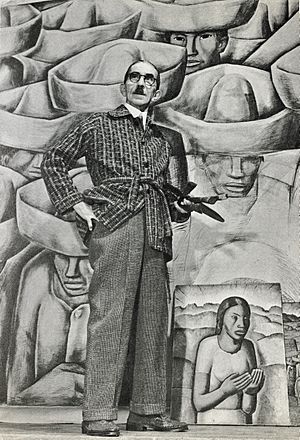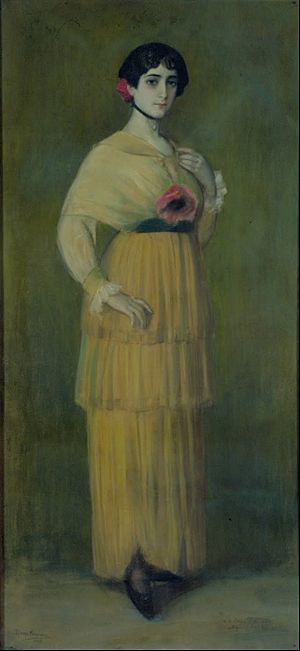Alfredo Ramos Martínez facts for kids
Quick facts for kids
Alfredo Ramos Martínez
|
|
|---|---|

Alfredo Ramos Martínez in Los Angeles, 1941. In the background, a drawing for the unexecuted mural, Los Charros del Pueblo.
|
|
| Born | November 12, 1871 Monterrey, Nuevo León, Mexico
|
| Died | November 8, 1946 (aged 74) Los Angeles
|
| Nationality | Mexican |
| Education | Academia Nacional de Bellas Artes, Mexico City |
| Known for | Painting, Fresco, Murals, Drawing, Watercolor, Printmaking |
|
Notable work
|
Margaret Fowler Frescoes (1945; unfinished), Scripps College, Claremont, California |
| Movement | Modernism, Mexican muralism, Figurative art, Portraiture, Impressionism |
| Awards | Grand Cross of the Order of Leopold (Belgium), 1923 |
| Patron(s) | Phoebe Hearst, (San Francisco); William Alanson Bryan (Los Angeles); Harold Grieve (Los Angeles); Albert M. Bender (San Francisco) |
Alfredo Ramos Martínez (born November 12, 1871 – died November 8, 1946) was a famous Mexican painter, muralist (someone who paints large pictures on walls), and teacher. He lived and worked in Mexico, Paris, and Los Angeles. Many people call him the 'Father of Mexican Modernism'. Ramos Martínez is known for his calm and kind paintings of everyday Mexican people and scenes. The famous Nicaraguan poet Rubén Darío once said that Ramos Martínez "paints poems; he does not copy, he interprets; he understands how to express the sorrow of the fisherman and the melancholy of the village."
Contents
Early Life and Art Talent
Alfredo Ramos Martínez was born in 1871 in Monterrey, Nuevo León, Mexico. He was the ninth child in his family. His father was a successful merchant who sold jewelry and fine fabrics. Everyone in the family was expected to join the family business. However, Alfredo showed a clear talent for art from a young age. His family supported his choice to become an artist.
When he was nine, one of his drawings won first prize at an exhibition in San Antonio, Texas. Part of his prize was a scholarship to study at the best art school in Mexico, the Academia Nacional de Bellas Artes (Academy of Fine Arts) in Mexico City. Because of this, his whole family moved to Coyoacán, a small town near Mexico City.
Alfredo was seen as very talented even when he was young. He loved using watercolor paints and won many awards. He felt that the school's teaching methods were too strict. He preferred painting outdoors, which is called plein air painting. Even as a student, he sold many of his artworks. He heard about the amazing Impressionist and Post-Impressionist artists in France. He felt he needed to go to Europe to learn more and build his career. His family wasn't poor, but they couldn't afford to send him to Europe.
Luckily, Phoebe Hearst, a very wealthy American woman, attended a dinner in Mexico City. The place mats at the dinner were designed and painted by young Ramos Martínez. Hearst was so impressed that she wanted to meet him. After their meeting, she bought all his watercolors. She also agreed to pay for his art studies in Paris.
Studying Art in Paris
Ramos Martínez arrived in Paris in 1900. This was a time when the Post-Impressionist art movement was growing. He saw the works of famous artists like Paul Gauguin, Vincent van Gogh, Henri Matisse, and Claude Monet. Phoebe Hearst sent him 500 francs every month, which was a good amount of money. He also spoke French well. This allowed him to live comfortably and travel around Europe.
In Paris, Ramos Martínez went to many art and literature gatherings called salons. He met the modern poet Rubén Darío from Nicaragua. They became close friends. This friendship brought Ramos Martínez into a group of interesting people, including dancer Isadora Duncan and poet Paul Verlaine.
Darío wrote a lot about the art and ideas that he and Ramos Martínez explored during these years. They traveled to Belgium and Holland to study the paintings of Rembrandt and Van Gogh. Ramos Martínez's art from this time was influenced by the dark colors of the Dutch sky and sea.
He also started painting and drawing on newspapers while in Brittany. This became a special technique he used later in California. He ran out of drawing paper during a holiday. The innkeeper offered him old newspapers, and he used them to create art.
In 1905, Ramos Martínez started showing his work at the yearly Salon d'Automne in Paris. This was a very important art show. Within a year, his painting Le Printemps won a Gold medal.
However, after this big success, Phoebe Hearst decided to stop his monthly payments. Ramos Martínez then had to work hard to earn money as an artist.
He showed his art in several galleries in Paris. A leading art critic, Camille Mauclair, said that Ramos Martínez's work was as good as the best Impressionist landscapes in Paris. Even though he was selling his art and was comfortable in Paris, he felt a strong desire to return home to Mexico in 1909.
Returning to Mexico and Open Air Schools

When Ramos Martínez arrived in Mexico in early 1910, the country was in chaos. The Mexican Revolution was starting, and President Porfirio Díaz's 30-year rule was ending. In 1911, art students at the National Academy went on strike. They protested the strict rules of the Academy and wanted a 'Free Academy'. They suggested Ramos Martínez as director. He was a respected former student, had succeeded in Europe, and understood their cause. He became the assistant Director and then the Director of the Academy by 1913.
As Director, he opened the first of his Open Air Schools of Painting. Inspired by the Impressionists and Post-Impressionists, he believed that an artist's personal vision was most important. His Open Air Schools changed how art was taught in Mexico.
The first school was in the Santa Anita Iztapalapa area of Mexico City. It started with 10 students, including David Alfaro Siqueiros and Federico Cantú, who later became famous artists. By 1914, Ramos Martínez left his role as Director of the Academy. But he opened another Open Air School in Coyoacán. That same year, his students' work was shown in an exhibition and received great praise.
Mexico's political situation remained difficult for the next ten years. In 1920, Ramos Martínez was made Director of the Academy again. Despite the politics, the Open Air Schools grew. Ramos Martínez was seen as a true innovator in Mexican art. He was often called the 'Father of Modern Mexican Art'. The artist Ramón Alva de la Canal even said that the real force behind modern Mexican painting was Alfredo Ramos Martínez, not Diego Rivera.
Ramos Martínez's ideas about art education also reached Japan. The Japanese painter Tamiji Kitagawa taught at the Open Air Schools in Tlalpan and Taxco in the 1920s and 1930s. He later became important in liberal art education in Japan.
While Ramos Martínez spent a lot of time teaching and setting up his schools, he also continued his own painting. In 1923, King Albert I of Belgium gave him the Grand Cross of the Order of Leopold. This was to honor his contributions to art.
In 1928, Ramos Martínez married Maria de Sodi Romero. Their daughter, Maria, was born a year later. She had a serious bone disease. Ramos Martínez resigned as Director of the Academy to find treatment for his daughter. The family first went to the Mayo Clinic in Rochester, Minnesota. They eventually moved to the warmer climate of Los Angeles, where Maria was cared for by Dr. John A. Wilson.
Life and Murals in California
After moving to Los Angeles in 1929, Ramos Martínez had an exhibition at the Los Angeles County Museum of Art (LACMA). Many more exhibitions followed, and he became very popular in Hollywood.
Harold Grieve, an art director for Warner Brothers and decorator for movie stars, bought many of his works. He also told his famous clients about Ramos Martínez's art. Film directors like Ernst Lubitsch and Alfred Hitchcock, costume designer Edith Head, and actors Charles Laughton and Gary Cooper were among those who collected his paintings.
Ramos Martínez also had successful shows in San Diego and San Francisco. In San Francisco, a well-known art supporter named Albert M. Bender saw his work. Bender became a lifelong friend and bought many artworks for his own collection. He also bought and gave Ramos Martínez's works to several San Francisco art places, including the California Palace of the Legion of Honor and the Fine Arts Museums of San Francisco.
Besides his skill in drawing, printmaking, watercolor, and easel painting, Ramos Martínez was an excellent muralist. He was very good at fresco painting, which is a difficult technique where paint is applied to wet plaster. Some of his murals were destroyed, but several important ones still exist. These include:
- The Chapel of the Santa Barbara Cemetery (1934)
- The La Avenida Café in Coronado, California (1938), which was later moved to the Coronado Public Library
- The unfinished fresco project, The Flower Vendors in the Margaret Fowler Garden at Scripps College, Claremont, California (1945). This mural was requested by the college because of Millard Sheets, a California artist who admired Ramos Martínez.
Another very important fresco by Ramos Martínez is La Guelaguetza. It was named after an old Oaxacan celebration of the Earth's gifts. This mural was painted in 1933 for screenwriter Jo Swerling's home in Beverly Hills. It was forgotten for many years but was saved in 1990 before the house was torn down.
Alfredo Ramos Martínez died suddenly at age 73 on November 8, 1946, in Los Angeles. He was buried at Holy Cross Cemetery in Culver City, California. When he died, he was working on a series of murals called "The Flower Vendors" at Scripps College. These unfinished murals have been kept as a tribute to him.
Remembering His Art
After Ramos Martínez passed away, the Dalzell Hatfield Gallery in Los Angeles continued to show his paintings and drawings. His wife, Maria Sodi de Ramos Martínez, made sure his work was included in many art shows. Until her death in 1985, she was the main person who promoted her late husband's art.
In 1991, Louis Stern Fine Arts held the first big exhibition of his work since his death. This show helped bring new attention to Ramos Martínez's art. It also led to a major exhibition called "Alfredo Ramos Martínez (1871–1946), Une Visión Retrospectiva" at Mexico City's famous Museo Nacional de Arte (MUNAL) in April 1992.
These exhibitions helped people look at Ramos Martínez's work again. Like other important Mexican modern artists, he often painted indigenous (native) people in his later works. In recent years, some of these paintings have sold for very high prices. For example, his 1938 painting Flowers of Mexico sold for over $4 million in 2007.
The Alfredo Ramos Martinez Research Project
Louis Stern Fine Arts started working with Alfredo Ramos Martínez's art in 1991. They held a special exhibition of his works. With his daughter, Maria Martinez Bolster, and art historian Margarita Nieto, the gallery created the Alfredo Ramos Martinez Research Project. Its goal is to "protect the artist's legacy and to advance the understanding and appreciation of the artist whom many have deemed the father of Mexican Modern Art." The project published a book called Alfredo Ramos Martinez & Modernismo in 2009. They are also creating a complete list of all his paintings and frescos.
Images for kids
-
Portrait of Belinda Palavicini. 1915. Pastel on paper. 187 × 87 cm. Museo Nacional de Arte.
See Also
 In Spanish: Alfredo Ramos Martínez para niños
In Spanish: Alfredo Ramos Martínez para niños
- Mexican muralism
- Mexican art
- Rosario Cabrera


